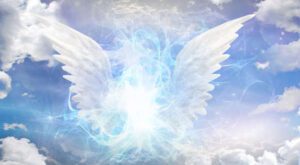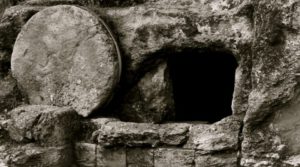Angels Who Saw It Happen
 Angelic accounts are found throughout the Old Testament, the Tenakh. Angels delivered messages and prophecies, dispensed judgements, provided protection and bore witness to special events – some of the Bible’s most profound.
Angelic accounts are found throughout the Old Testament, the Tenakh. Angels delivered messages and prophecies, dispensed judgements, provided protection and bore witness to special events – some of the Bible’s most profound.
Abraham was on Mt. Moriah about to sacrifice his son when an angel called out from Heaven to spare the life of his only son, Isaac. Caught in a nearby bush Abraham then saw a ram and used it as a substitute sacrifice.
Calling out again, the angel’s voice delivered God’s message that Abraham and his descendants would all be blessed for his faith.[1] Abraham eventually became the patriarch of Judaism, Islam and Christianity.
Balaam’s donkey was blocked by an angel messenger of God when Balaam attempted to go to King Balek on his own volition rather than first waiting to see if God gave him further directions. Eventually allowed to proceed with meeting Balek, the angel commanded Balaam to only say to the King what God instructed him to say.[2]
King Balek wanted Balaam to place a curse on the Hebrews in an effort to prevent them from defeating his own nation. Instead, Balaam issued a prophecy considered to be the first direct Messiah prophecy foretelling that a future star would shoot out from Jacob and a scepter would arise from Israel.
Judgement was dispensed by an angel sent from God for King David’s sin of failing to have faith in God’s promise of protection. David had enumerated his warriors to determine the strength of the army.[3]
To obtain forgiveness for his grave sin, at the direction of Gad the prophet, David built an alter and offered a sacrifice on Mount Moriah. Moved by the events, the King issued a royal command that this location on Mount Moriah would become the future location of the Temple later built by his son, Solomon.[4]
Mouths of the lions were shut when God sent “His angel” to protect Daniel when King Darius had him thrown into the lion’s den.[5] Later in his life, the angel Gabriel interpreted for Daniel his vision of the 70-week prophecy.[6]
– – – – –
Gabriel would again appear hundreds of years later in the Gospels. First, the angelic messenger of God appeared to priest Zechariah in the Temple to announce that his older and barren wife, Elizabeth, would bear a son to be named John.[7] Their son would later become known as John the Baptist, the forerunner messenger of Jesus of Nazareth.[8]
LK 1:18 Zechariah said to the angel, “How can I be sure of this? For I am an old man, and my wife is old as well.” The angel answered him, “I am Gabriel, who stands in the presence of God, and I was sent to speak to you and to bring you this good news.”
Six months later, Gabriel appeared to Mary with a message from God. “And now, you will conceive in your womb and bear a son, and you will name him Jesus.”[9]
Joseph, Mary’s betrothed husband, was unaware of God’s message to Mary and considered divorcing her for infidelity. Before Joseph reached a final decision, an angel appeared to him in a dream with a message that Mary’s conception was from God to fulfill Isaiah’s prophecy – she was not by pregnant by another man.[10]
Shepherds in the field outside of Bethlehem were visited by an angel whose appearance shone around him and the hard-core shepherds wanted to flee. The Greek text word phobeo is translated as “terrified,” “greatly afraid,” and “terribly frightened.”[11] Calming the shepherds, the angel told them not to be afraid because he was bringing good news and great joy for everyone:
LK 2:11 “for today in the city of David there has been born for you a Savior, who is Christ the Lord.”[12]
As the minds of the shepherds whirled, suddenly an unexpected spectacular event occurred – a host of angels appeared in the sky heralding the birth of Jesus.
“Host” is translated from the Greek word stratia meaning a vast number of troops; a number so great it is likened to the countless number of stars in the sky.[13] In the largest angelic appearance ever recorded, a multitude of angels praised God, “Glory to God in the highest, And on earth peace, goodwill toward men!”[14]
Shepherds who experienced this most amazing event decided they would to go into Bethlehem to find this thing proclaimed by the angels. In Bethlehem they would find the newborn baby wrapped in swaddling clothes lying in a manger.
Two angels witnessed the Resurrection of Jesus, according to the initial empty tomb encounter chronicled in Luke. Matthew and Mark only describe an individual angel speaking to the women at the tomb although a second angel’s presence cannot be ruled out.[15] Noteworthy is that Jewish Law required two witnesses to establish a legal fact.[16]
Written by the same author of Luke, the Book of Acts describes two men dressed in brilliant white clothing appearing to the witnesses from Galilee who were fixated on seeing Jesus rise from the ground into the clouds.[17] These two angels are described in very similar terms as the angels at the empty tomb and many Bible experts consider them to be the same angels.[18]
In both instances of the Resurrection and Ascension, the angels asked the witnesses why they marveled at what they were seeing? Reflected in their questions, the angels seemed to be puzzled by the human reactions at what the angel’s regarded as not all at surprising to them:
LK 24:4-5 While they were perplexed about this, suddenly two men in dazzling clothes stood beside them. The women were terrified and bowed their faces to the ground, but the men said to them, “Why do you look for the living among the dead? He is not here, but has risen.” (NRSV)
Acts 1:10-11 While he was going and they were gazing up toward heaven, suddenly two men in white robes stood by them. “Men of Galilee, why do you stand looking up toward heaven? This Jesus, who has been taken up from you into heaven, will come in the same way as you saw him go into heaven.” (NRSV)
If angels witnessed and participated in key events in the Old Testament, the Tenakh, does it make sense that angels would be heavenly witnesses to the events described in the New Testament?
Updated May 4, 2024.
This work is licensed under a Creative Commons Attribution-NonCommercial-NoDerivatives 4.0 International License.
REFERENCES:
[1] Genesis 22:11-12, 15-18. A little lower than the angels? FaithRoot. image. 2020. <https://faithroot.com/2020/06/03/a-little-lower-than-the-angels/>
[2] Numbers 22:1 – 24:19. Commentary. BibleHub.com. 2020. <https://biblehub.com/numbers/22-22.htm>
[3] I Chronicles 21:1-30. 2 Samuel 24:10-17.
[4] I Chronicles 22:1; 1 Kings 6:1, 37-38. CR 2 Chronicles 3:1-2.
[5] Daniel 6:6-21.
[6] Daniel 9:20-23. CR Daniel 8:15-18.
[7] Luke 1:8-21.
[8] Luke 1:17; John 3:28.
[9] Luke 1:26-38. NRSV – Luke 1:31.
[10] Matthew 1:20.
[11] Luke 2:9. “phobeo <5399> NetBible.org. Luke 2:9. Greek Text. <http://classic.net.bible.org/strong.php?id=5399>
[12] NASB.
[13] “stratia” <4756> NetBible.org. Luke 2:13. Greek Text. <http://classic.net.bible.org/strong.php?id=4756>
[14] Luke 2:14. NKJV.
[15] Matthew 28:5; Mark 16:5; Luke 24:4.
[16] Deuteronomy 17:6; 19:15; Numbers 35:30. Luke 24:4-7; John 20:2, 13. CR Matthew 28:2-8; Mark 16:5-7;
[17] Acts 1:10-11.
[18] Commentary. Acts 1. BibleHub.com. 2020. <https://biblehub.com/acts/1-10.htm> “Ascension.” Encyclopædia Britannica. 2020. <https://www.britannica.com/topic/Ascension-Christianity>

